#ampify
Explore tagged Tumblr posts
Text
Harmless Figments
Hello World again, greetings from Geneva! That’s where the turmoils of life have cast me for the time being, to make a living in the corporate world whilst sorting out a family matters left unsolved back in lovely France. I have meant to post a few things on these pages over the past few months, however impediments have been countless. Welcome to Geneva! (Image generated by Dall-E) Without…

View On WordPress
0 notes
Text

Lightdeficient's Luumia Body Hairs Updated Recolored in AMPified
requested by @melsie-sims, hope you enjoy!!
60 add-on swatches in @everything-amp's AMPified Palette
Meshes are not included and can be found here
All credit goes to @lightdeficient for these conversions!
Download: Patreon/SFS
@maxismatchccworld @mmoutfitters @alwaysfreecc @public-ccfinds
66 notes
·
View notes
Text
Audio Power Amplifier Trader

ATI Pro Technologies is a distinguished name in the audio industry, renowned for its extensive selection of speakers and sound systems. As a premier supplier, wholesaler, and importer of audio power amplifier boosts low-level audio signals to a level suitable for driving loudspeakers. Essential in audio systems, it enhances sound clarity and volume while maintaining signal fidelity. Designed for both professional and consumer use, it ensures optimal performance in various applications, from concerts to home theaters.
0 notes
Text
Alina and the Darkling’s interactions, pt. 14
(But also a bit of Malina drama and the Darkling’s qualities of a decent leader.)
Siege and Storm- Chapter 3

Twice a traitor, twice deserter, murderer of her fellow soldiers, staying in a comfy private cabin, fed, allowed to see her beloved fellow deserter... What a life!
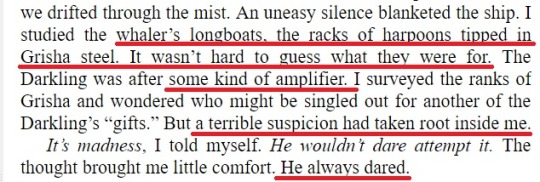
I feel like there’s a step missing. Alina doesn’t know about the Sea Whip and its properties, yet she “figured out” the Darkling wants the amplifier for her. Based only on the assumption he’s insane and what’s more nuts than two amplifiers?! Good thing she’s the MC, so it works...
Remember, children: Even a person prone to jumping to conclusions can occasionally land on the correct one!
It’s madness, I told myself. He wouldn’t dare attempt it. The thought brought me little comfort. He always dared.
One of the Darkling’s best qualities. If there’s a way, he’ll try it.

Stupid? Yes. Gullible? I’m sure the Darkling would wish so.
“Someone less stubborn? Less selfish? Less hungry for the life of a mouse? Believe me,” he said, “I wish I could.”
The Darkling’s often accused of wanting Alina weak and malleable, but the text shows quite the opposite! He wants confident Queen, only more open-minded and compassionate. He wants her proud and powerful, but helpful to Ravka and Grisha alike.
A Grisha can have only one ampifier. You told me that yourself.
No, he did not:
“If we have any hope of destroying the Fold, we need the stag’s power.”
“But maybe if I had one to practice with—”
“You know it doesn’t work that way.”
“I do?”
He frowned. “Haven’t you been reading your theory?”
The Darkling lets Alina draw a conclusion, but he doesn’t say she cannot get an amplifer, because she couldn’t have the Stag otherwise. I can see three possible reasons, all probably true.
a.) There’s no need for her to know about the rest yet.
b.) Alina’s main problem is lack of training, no skill. Amplifier for practice would only increase that power she cannot control.
c.) Why waste perfectly good amplifier on someone, who’s getting another?
I don’t understand why is the Darkling explaining anything to Alina. She’s obviously not willing to cooperate, yet he’s still schooling her. Somehow not giving up on her...

I thought of the books I’d read on Grisha theory.
So, like three?
Alina sounds like a spoiled brat. I want, I want, I want! This is the main character in a world full of wars and suffering. Her tantrum reminds me of a certain evil step sister from a certain Russian fairy tale...

When we’re there, the irony of the antagonist being the one to set aside his desires to achieve what’s more beneficial for others is also something else...

Back to insulting the antagonist right in his face... because it’s the most mature reaction to disagreement and the safest way to persuade him not to kill your beloved LI.
You can’t control the Fold. It has to be destroyed.
... I know, because I’ve studied merzost for centuries like half an hour, when YOU were using it in front of me! Strategy for even longer, because that’s in every map maker’s poor, poor orphan’s curriculum!
I love when the Darkling’s rational about Alina’s usefulness.
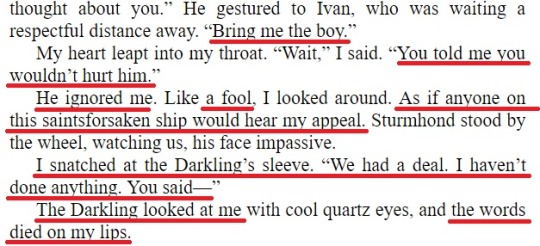
Alina once again assumes her precious Malyen’s gonna get hurt, even though the Darkling just told her how much he’d love to do it, but can’t... They’re both treated far better than they should’ve been, yet Alina’s first thought is death and torture. Just like back in the day, when the Darkling dare to ask about her day...
Like a fool.
Alina’s self-criticism's well deserved, but for different reasons than she wants us to believe. She’s not some defenceless victim surrounded by enemies, she’s merely close to facing consequences of her own reckless actions.
fool1/fuːl/
noun: fool; plural noun: fools
1. a person who acts unwisely or imprudently; a silly person.
And there’s nothing silly about her, or about anything she caused so far.
Aleksander’s done with her hysteria, but (un)fortunately possesses inhuman amount of self-control.

17 y/o voice: It’s a fairy tale. A children’s story. It doesn’t actually exist. I would know. I got out of our tiny village like a year ago...
“Like the stag?”
“... or my sister? Oh, my mother didn’t mention her, when unearthing family dirt? She IS a mermaid, btw...”
I just have to add this thread...
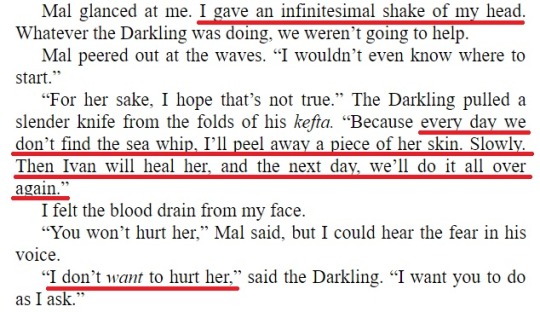
Let’s make infinitesimal a new effervescent!
Mal glanced at me. I gave an infinitesimal shake of my head.
Totally unexpected, and surely unnoticed by any Corporalki... but a moment later, the Darkling threatens to torture Alina and make Ivan heal her. Does it mean they don’t have any Healers with them? They would be less likely to survive and escape to join their general, if we use the “selfless doctor” stereotype to explain. Less used to combat, probably protecting their patients... Non-warriors are always easiest to kill.
Another proof the Darkling doesn’t enjoy cruelty or torture. He certainly knows when to use it, or threaten to do so, but never with other way at hand. Also, as a decent leader, he won’t have his people do something he’s not willing to do himself.

How doesn’t anyone find this suspicious? I’d thought Sturmhond has a reputation to uphold. ... and not one of the knight in shining armour!
I also need to link this amazing AU, where Sturmhond has the balls to act like a ruthless pirate.

The Darkling casually dismisses Sturmhond’s objection, to focus on matter at hand- namely persuading melodramatic couple to cooperate, since neither of them's willing to see the other harmed in any way. There’s no need to cease his actions, because unlike Sturmhond he’s aware they will never get to the torture.
He doesn’t waste time or breath on Sturmhond or his crew. They can be dealt with later, when Malina’s not present. The Darkling doesn’t show or tolerate disunity on the ship in front of the prisoners.
He uses theatrics to stall and unsettle Malyen. I have a suspicion that even the fact he’s touching Alina’s enough to bother the tracker.
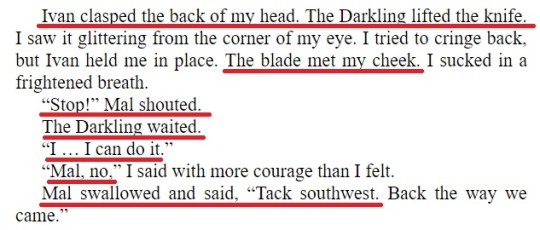
They’re so easy! There’s not even a scratch yet, and Malyen breaks! It’s probably supposed to show how much does Alina matter to him, but heroes should struggle, not cave in as soon as someone pulls out a knife! This way they look incredibly weak and I don’t understand, why should reader root for them.

I know this is supposed to be Mal putting Alina’s well-being first, but he reads like a spineless coward.
The Darkling’s pretty generous for an insane megalomaniac, isn’t he? A week was Sturmhond’s first suggestion. Is it partly to appease him?

This is just PATHETIC.
I feel like I’m reading Rosamunde Pilcher, not ‘chosen one’ kind of fantasy. I guess I understand noble silent suffering more than constant screaming of each other’s names.
They DO love their drama....
All previous parts.
#Grishaverse#Grisha trilogy#Siege and Storm#S&S Chapter 3#Alina Starkov#The Darkling#Darklina#Alina and the Darkling’s interactions#The Darkling being a very good general#grishanalyticritical#Malyen Oretsev#V#Sea Whip#Morozova's amplifiers#Shadow and Bone (book)#S&B Chapter 12#Ivan Kaminsky#Grisha loyalists#Sturmhond#Nikolai Lantsov#Second Army#books#quotes#Leigh Bardugo#anti Malina#anti Mal
89 notes
·
View notes
Note
I thought it's only me who think 127 seem really lack in physical bonding compare to other boys group ha ha. I watch some riize content lately and you can just pick 2 random people in that group and they are touchy with each other a lot, like all the time, they hands always have to reach out to the next person whether standing or sitting. So it's not a generation thing, newer gen can still be like that. I try to think of a reason, and the only thing I can come up with is maybe other groups don't have an actual gay cp like 127? Straight dudes/platonic friends actually can go pretty wild with each other, even not for show. At some point I even have a conclusion that the more they act gay comfortably the more likely they're straight lol
They have their moments, but yeah, they are much less physical and expressive in comparison to many other groups. Even them being chaotic is often played up (they are weirdos, but the reactions and the funny factor are ampified for entertainment).
It's not just JaeDo. Tae likes to clings, but is squirmich. Taeil gets bothered when others go too far. Yuta doesn't like physical contact. Mark also has his limits.
Different factors play their role: 1) the big age gap, 2) foreigners, 3) the leaders setting the tone, 4) They are a bung of introverts.
And yes, come to think of it, the strongest platonic friendships in 127 involve a gay. And because Haechan uses the physical contact to bother, others push him away out of irritation (like Mark or Taeil).
Johnny and Taeil are the closest to a straight dudes pair, but Taeil is small, so he is not very comfortable with being treated like a teddy bear.

Indeed, it's always Mark.

2 notes
·
View notes
Text
Inspiration
Charatcer
I want my characters to feel unique and fresh. I've taken inspiration from a wide range of sources, from fashion designers and runway shows to make up artists to 3D renders depicting interesting art styles.
lberto Mielgo is currently my favourite animation directed,m his unqiuew art style and breathtaking visuals combined with intresting shots is the base for a lot of my ideas. I want to explore the hybrid 2D 3D style he uses but make it my own at the same time. I find the way he uses location and camera in his work to be spomething new. His use of camera ampifies emotion and tension and I want to replicate these feelings in my work.



His works such as Jibaro and The Witness really push the boundaries in character design and story telling. With his recognisable style he has created memorable and iconic animations. I want to capture some of the creativity and passion that he has so successfully done.
Other sources of inspiration include the make up artist Raoul Alejandre



Artwork from Mariusz Lewandowski, Jon Juarez and John Harris









Animations such as Akira, Mutafukaz and Zima Blue









5 notes
·
View notes
Text
Closed starter for @retroactiive

Rolling her eyes as their snoring got louder, Nicole was really trying to let them sleep but the snores just kept getting louder and louder as Cocaine Bear continued to play. She’s been waiting for this movie for two weeks now, and they were ruining it. Trying to drown out the snoring by upping the volume. Trying to concentrate on the movie, she felt a shift on the couch, turning towards the person, their snoring suddenly ampified; Nicole had enough. Getting up from the couch, she grabs one of her couch pillows and throws it at them, "Get up, you're snoring and i can't hear the movie."
5 notes
·
View notes
Note
☂ - THUNDERSTORM - a difficult or miserable time in their life
The cold had begun to spread to the tips of her fingers and toes. No longer was the adequate fire doing it in terms of bringing Rickie alittle warmth and comfort to quell the chill that crept up her spine and straight to her head. Desperately she curls fists into the blanket strewn around her shoulders, draping her enough to cover the majority of her figure.
She had taken the initiative when she felt better before the day had dragged on to dress warm -- She knew the mountains of Hillsbrad could be particularly treacherous in the winters, it went without saying that their out cropping pathways only ampified the shade necessary to keep the bite of winter strong. And by god, didn't the coyote feel it.
Her hounds had made extra effort to keep to her side, sensing the depression developing as a wet coughed wracked throughout her body -- She could feel it's misery in her very bones, her back aching and head throbbing, eyes squinting with effort. She was trying to concentrate on the fire, it's little flickers of images and patterns...
Am I hallucinating..?
She felt unsure, suddenly, her brows furrowing. The dogs responded, ears perked with alertness to the shift. The male rose and, unprompted, began a strong stride up the path they had only just pulled off from. The late decision to camp for the night had come only after hours of unsteady offroading -- The snow had thickened after an hour of going longer than she typically would... Not much snowfall, something they had been easily wading, but enough to exhaust the body. And Rickie was bone tired, suddenly more than ever. Flushed faced she'd begin the effort to crawl back inside the tent -- Though it provided little insulation against the wicked wind beating through the fabric walls of her simple a-design. It was still some shielding from the growing storm.
Her retriever, the bitch of her two dogs, would crawl in after her, keeping close to Rickie's chest, trying to tuck her maw into the womans neck to promote alittle heat between bodies as her master was quick to sleep... Bundled up in her tent beneath a blanket and a fever plus congestion invading her senses with one dog cuddling her and the other out hunting for help. Her fire would smolder eventually, the wind growing vicious as the night dragged on...
A miserable time, indeed.

Thank you, @captzexx!
1 note
·
View note
Text
Experimental song created in Ampify Blocs Wave, sequenced in Novation Launchpad — January 4, 2025.
0 notes
Link
When you get close to a black hole, things can get pretty intense. The tremendous gravity can squeeze gas to ionizing temperatures, and fierce magnetic fields can accelerate plasma into jets speeding at nearly the speed of light. That’s a lot of power, and wherever there is power someone will figure out how to harness it. Back in 1969 Roger Penrose noted that you could theoretically extract energy from a black hole simply by dumping garbage into it. The idea was to pack a spaceship full of junk, fly really close to a black hole so that you travel within the region of strongly twisted space known as the ergosphere, then simply dump your trash. The trash gets consumed by the black hole and your spaceship gets a boost of energy. No need to reduce, reuse, recycle, just toss it down the cosmic hole. How to turn trash into energy. Credit: Atomic Rockets, adapted from Misner, Thorne and Wheeler While this should work in principle, the engineering needed to carry it off would be challenging, and harnessing energy from a fast-moving rocket wouldn’t be very efficient. Fortunately there should be another way, just using electromagnetic waves. In 1971 Yakov Zeldovich demonstrated how a rotating black hole could amplify electromagnetic waves. Essentially if you beam light toward a rotating black hole, some of the light will be ampified due to the frame dragging of gravity. At least in theory. Therein lies the problem. While all of this is theoretically sound, we don’t have a spare black hole lying around to prove it. Luckily the Zeldovich effect works for more than just black holes. Zeldovich showed that the effect should work for any rotating body that absorbs a bit of the energy aimed at it. So you should be able to bounce light against a rotating cylinder and see the effect. No black hole needed. The only problem is that the cylinder would need to rotate at relativistic speeds and the effect would be tiny. Then in 2020 a team showed how a similar effect worked with sound waves. They beamed low-frequency sound waves into an absorptive rotating disk and measured an increase in acoustic energy, proving the Zeldovich effect worked for sound. Measuring the electromagnetic Zeldovich effect. Credit: Braidotti, et al Now the team is back with a new paper showing the effect with electromagnetic waves.[^4] The way they did it was to adapt a resonant circuit. The circuit could focus an oscillating magnetic wave through a through an aluminum cylinder. By itself the cylinder would act as a simple resistor and dampen the magnetic field, but when the team rotated the cylinder in a particular way the magnetic field was amplified just as Zeldovich predicted. Since aluminum isn’t magnetic, the isn’t due to some dynamo effect. Thus the team could demonstrate it is a new effect. So we now know rotating bodies, including black holes, can amplify electromagnetic fields. What’s also interesting about this experiment is how surprisingly straight forward it is. The design is similar to an induction generator used in wind turbines. The experiment could have been done decades ago, it’s just that no one had thought of it before. Sometimes the answer to a scientific question is right in front of you. Reference: Braidotti, M. C., et al. “Amplification of electromagnetic fields by a rotating body.” Nature Communications 15.1 (2024): 5453. The post Researchers Mimic Extracting Energy From Black Holes in the Lab appeared first on Universe Today.
0 notes
Text

Euphoria Set Recolored in AMPified
60 add-on swatches in everything-amp's AMPified Palette
Meshes are not included and can be found here
All credit goes to @daylifesims for these hairs!
Zip is too big for Patreon, so it can be found on Simfileshare instead
Download: SFS
@maxismatchccworld @mmoutfitters @public-ccfinds @alwaysfreecc
27 notes
·
View notes
Note
Dear, I hope you are doing well
This is me, Abdallah from Gaza 🍉🇵🇸
I am wondering if possible, to help and support us by sharing my donation campaign in your blog
My family (my old 96-grandmother, mother, father , 2-sisters, 2-brother and also my 2-brothers family members) is in great danger due to the ongoing war in Gaza and I am running this campaign to save them to cover the basic daily life for my family.
I really appreciate your efforts to share our voices
Regards from Gaza,
OFC MAN!!!!!!!!!
If you guys can do a favor and donate to Abdallah and his family to help their needs.
They're at $3,000 and and they need $65,000 to help them out.
you can donate $5, $10 or even $1! every donation matters. I myself can't donate but i'm using my voice to ampify to share their voices.
1 note
·
View note
Text
Corb in the Corner • Living with Le Corbusier...

Le Corbusier’s ideas are usually viewed separately; but they are all the same thing
Marc Perelman 2005
Introduction
My father knew, and I grew up with, the Swiss-French architect, Charles-Édouard Jeanneret, known as Le Corbusier, and identified in familiar form as, Corb. I don’t mean that Dad knew Le Corbusier personally, of course he didn’t. But he had learnt about his work as providing the foundations of modern 20C architecture. For architects of his generation, and involved with the great rebuild g after WW2, Corb was recognised as the patriarch and guiding genius of the profession.
Corb was a familiar presence at home, and amongst my father’s colleagues and friends, and also from the pages of various architectural and design journals that came home. We had books about Le Corbusier on our shelves at home.
My parents were artistic without being completely bohemian. My father was a very practical kind of architect. As a young designer, and in the context of post-WW2 austerity, he had made his own furniture in the style of Robin Day and Ernest Race. Dad also built a kit-car and a radiogram. The radiogram comprised a valve ampifier with VHF tuner, and with a deck for playing records arranged in a cabinet with a hinged lid. The amp and radio took a few moments to warm up before working…
The various strands of Dad’s practicality were evidenced in his choice to repurpose a cast-concrete white-painted drainpipe, from Coventry, as the speaker cabinet for the radiogram. The drainpipe stood vertically with the loudspeaker resting, and fitting exactly, into the top opening. The pipe stood on a disc of polished wood (teak maybe) that was cut so as to allow the speaker cable to emerge neatly from within the pipe. This whole thing stood, about four-foot high, in the corner of the living room until, as a teenager, the radiogram and speaker were moved to my bedroom. The radiogram was about twenty-five years old when I took it over.
The drainpipe-speaker did several things for me. It gave me an early taste of concrete as a material that combined economy and heft, and that could also be enjoyed in the context of domestic comfort. The drainpipe also introduced me to ideas about the sculptural potential of ordinary objects, and the appeal of material integrity. It took many years for me to unpack the connections, implicit within this object, to design-reform, Le Corbusier, and to Duchamp’s Fountain, and to the found-object artworks of Picasso, and to all the rest of art and philosophy, and to my own engagement with and experience of things.
Nowadays, I recognise our drainpipe-speaker as a totem object in our household…exemplifying and celebrating a world in which cultural sophistication and material economy combined…as an art-brut style expression of the exquisite everyday. Most importantly, the drainpipe showed me that every object, however prosaic, could be enjoyed through a combination of imagination, feeling and creativity, and understood in terms of ideas, emotions and personalities; so as to provide a world of art, experience and wonder…on the doorstep and in plain sight. As I got older, I began to discover the same possibilities in the shops, galleries, museums and houses that we visited.

Machines for Living (and being)
Quite a few off the houses we visited were lived-in by architect colleagues of my father, and with their families. These houses, mostly in the south-east of England, were identifiable by their open-plan living, white-painted walls, maxed-out gazing, asymmetric lighting and outsize Japanese paper-lantern shades. Later these houses were further modernised and extended so that the kitchens became larger multi-purpose spaces with fold-away glass walls that blurred the interface between indoor and outdoor space. Now, I recognise these houses as iterations of Le Corbusier’s concept of the house as a machine for living, In the UK context, few of these houses were new-builds; mostly, the machines were enclosed within historical structures of English domestic building; whether Georgian, Victorian or suburban.
The machines-for-living concept is often misrepresented by reference to FW Taylor's Scientific Management, and the claim to labour saving efficiency, rationality and convenience. The Frankfurt Kitchen (1926) is the exemplar for this. Le Corbusier's machines incorporate some elements of this convenient practicality, but the spatial machine is very much more expansive in what is potentialises.
I work at Central Saint Martins, part of the University of the Arts London. The school moved to Kings Cross/St Pancras in 2012. The new building, designed by Stanton Williams, sits within 19C railway buildings that formed an historic freight terminal for the supply of grain to London. The original station platforms have been removed and their site now defines a three-storey block of studios and workshops, arranged around a floor-to-roof height and full-length-of-the-building atrium space. This modern structure is all interior space and large glazed openings expressed through the combination of glass, steel and concrete. In contrast, the original front-facing Granary building, designed by Lewis Cubitt, is built of stone, brick, cast-iron and timber.
The old building is lovely example of the functional 19C warehouse type. The structure and shape of the building is entirely derived from the specification of its materials. By modern standards, the whole appears relatively small-scale. Inside, its five storeys appear low-ceilinged and with floor-spans interrupted, at regular intervals, by cast-iron columns that provide internal support. Notwithstanding these limitations, the building is comfortably Vitruvian in scale and popular with students.
There’s a really exciting spatial transition associated with the experience of moving from one scale of building and materials, circa 1840, and into another, bigger open structure (2012). The effect is literally mind-blowing; which is just right for creative thinking. That TARDIS effect of spatial expansion, expressed through structure and materials is entirely derived from Corb, and described as shifting from Vetruvian to Modular scales. There's also an implied accelerating effect. The Granary building is the smallest of new-builds across the KX campus development.
My own interest in communication design developed as a consequence of my own experience of the open-plan associations facilitated in the department store and museum developments of the 1960s and 1970s.
The scale and scope of open-plan living proposed by these structures, whatever their external form, provided for a reaction against the tyranny of small-spaces evident in the separate-rooms-for-separate activities evident in the organisation of the traditional home. This spatial organisation implied a separation of functions and concepts that tended toward compartmentalisation, hierarchy and isolation. The dynamic and connected space of Corbusier suggested a wider range of positive interactions, and established modern architecture as a form of social practice in expanding space.
In the 1960′s and the 1970′s, modern engineering combined with ideas of a different kind of cultural experience and produced the fun-palace concept. In Britain, the architect and theorist, Cedric Price, used the potential of the mega-scaled space-frame to conceptualise a multi-function structure. The legacy of this idea may be seen in the present-day scale and design of airport terminals, shopping malls and so on.
Part of what Cedric Price had imagined was an architecture that was structural and systemic; but also social and cultural. Co-incidentally, the social potential of civic space had been described and promoted by Ernesto Rogers (Richard's uncle) in Italy.
The big idea of the Pompidou Centre, entirely derived from Le Corbusier and Price, and designed by Richard Rogers and Renzo Piano, and with engineering by Peter Rice, was that this big building should have a completely open floor plates. This would allow for maximum versatility and visibility. Accordingly, the supporting structure of the building had to be externalised.
The external structure of the Pompidou Centre is all about lightening-the-load and keeping everything stable. The building is pretty big and there’s are some substantial compression loads from within the main structure. All those traditional internal columns, that would have kept the roof on, had to be pushed onto the outside and dissipated through a triangulated lattice of ties.
The crucial part of the structure is a pivoted lever element called a gerberette. This is a cantilever that balances the internal compression of the structure and transfers it to the external lattice of tensioned metal ties. The gerberette parts are cast steel and weigh 11 tons each…but they have lovely sculptural quality. That’s Corb and Mies combined, and with Brancusi etc.
I love the way that the Beaubourg building combines a number of ideas from the history of architecture
Gothic flying buttresses…
Sail boat rigging (Frei Otto)
The architecture of infinite-extension (Joseph Paxton)
The space frame and the geodesic lattice (Buckminster-Fuller)
The open-plan (Le Corbusier)
So, although the form of the building is expressed using 20C materials, the ideas that those forms express are much older. Crucially, the spaces opened up by Beaubourg were beyond the existing budgets and resources attaching to institutional colleagues. This provided a break-out space from the siloed thinking of longer established museums and galleries.
The new spaces of Beaubourg encouraged curators to develop new ways of showing things and created an environment in which the connections between things became more clearly evident. In curatorial terms the spaces undermined the usual ownership of culture by effectively by-passing the gate-keepers of compartmentalised objects and culture. Thus high and low were brought together, and everything became more visibly connected. This was the beginning of an inter-textual hyper-reality. The galleries provide a space in which objects, images and texts seem to float in space…I love that. In the UK, this model was perhaps most clearly realised in the retail environment of the Biba store.
Looking back, I now understand that I internalised these structures and, as far as I was able, these systems of thinking. I did that thanks to family and friends who took me around palaces, and shops, and showed me how life could be lived and how things could be arranged.
When I began to build my own mind-palace it was quite architecturally specific. It was a high-tech structure derived from the Eames House (kit of parts) and at the scale of Piano and Rogers, and with the open-plan space of Le Corbusier. There's also a bit of Jean Prouvé, and Cedric Price, and Malevich. I want my big buildings to have big spaces that connect people and things.
There are no corridors in my mind-palace, and the rooms are configured by the artful arrangement of objects, people and moving images…The whole thing is a cross between how I imagine Biba (I never went there) and what I got from Beaubourg and Versailles.
From the 1980s and onwards, I worked in the art world. This helped me develop my visual memory so that I have really good recall of the spatial arrangements of objects in room-settings - furniture, pictures, objects, people and books etc.
As I’ve got older, the whole thing has become a bit more 18C looking. That’s slightly weird; but I’ve definitely developed a taste for parquet floors. I also like the patina you get on old-fashioned linoleum after about twenty years.

Dom-ino (1914)
Le Corbusier had previously worked in the studio of Auguste Perret where he had been introduced to the structural potential and economy of reinforced concrete. The advent of WW1 unexpectedly provided Le Corbusier with the opportunity to conceptualise an inexpensive and simple domestic-scaled concrete frame, or platform, that could be mass-produced and combined, like dominos. Le Corbusier hoped to address, through this concept, the unfolding humanitarian crisis of housing shortage and displacements attaching to conflict, disaster and progress.
Le Corbusier’s schematic proposed three slabs, raised on six concrete posts and with a cast-concrete staircase elements connecting ground to first-floor, and roof. The practical economy of the concept belies the exciting potential of separating the structural function of walls from their space and activity-defining roles. The open-plan floor system was understood as multi-function and flexible, and the exterior walls transformed so as to afford larger apertures to provide transparency and greater in-and-out movement. The Dom-ino prototype suggests a set of guiding, abstract and idealised principles to direct modern architecture.
Corbusier’s concept combined a number of important ideas in relation to modern building: economy, mass-production, pre-fabrication, modularity, system assembly, functionality, co-design and scalability. Nevertheless, this potential remained largely ignored within the context of house-building until after WW2.
Le Corbusier explored the potential of the dom-in concept through a series of iterations in various forms, and optimisations of space and function. The most famous of this variants are
The Citrohan Concept House (1920)
The Pavillion de L’esprit Nouveau (1924)
The Villa Savoye (1927)
These experiments allowed Le Corbusier to more clearly define the basic architectural principles that had shaped the development of the original concept. These were
Free design of the ground plan – commonly considered the focal point of the Five Points, with its construction dictating new architectural frameworks. The absence of load-bearing partition walls affords greater flexibility in design and use of living spaces; the house is unrestrained in its internal use
Pilotis – a grid of slim reinforced concrete pylons that assume the structural weight of a building. They are the foundations for aesthetic agility, allowing for free ground floor circulation to prevent surface dampness, as well as enabling the garden to extend beneath the residence
Free design of the façade – separated exterior of the building is free from conventional structural restriction, allowing the façade to be unrestrained, lighter, more open
Horizontal window – ribboned windows run alongside the façade’s length, lighting rooms equally, while increasing sense of space and seclusion. As well as providing interior spaces with better light and view of the surroundings
Roof garden – flat roofs with garden terraces serve both harmonic and domestic utility, providing natural layers of insulation to the concrete roof and creating space

Economy + Scale Flexibility + Possibility
The machine for living, as evidenced by these examples and characteristics, is not a thing of mere convenience; it is a space of dynamic and transcendent possibility, that can expand and shape-shift as required. The Corbusian machine is conceptualised as a mechanism of association and aggregation as much as one of functional productivity. The model is less straightforwardly instrumental or deterministic than the Fordist models to which the concept is usually attached.
Accordingly, the spatial characteristics of architecture became the primary focus of Le Corbusier’s thinking, with materials, scale, structure and specification each serving the spatial priority of experience and practicality. These principles and logic have continued to inform the development of 20C architecture in terms of scale, materials, economy and possibility.
The consideration of architecture as a cultural form is nearly always concerned, with the outward appearance of buildings. Le Corbusier shows us that this is misguided. The outward appearance of buildings is very nearly their least interesting characteristic. The consideration of space, structure, scale and specification in relation to buildings is helpful to understanding how form, function and experience are related. This arrangements of ideas is also suggestive of an architecture without buildings and a focus of interactions and outcomes as an expression of architectural practice.
By a happy co-incidence, the three master architects of the modern movement each focussed their efforts on one of these characteristics; Le Corbusier on space, Water Gropius of structure, and Mies on the elegant details and alignment of specification.
Each of these masters, and the architectural profession generally, have often been identified as megalomaniacal egomaniacs. The dom-ino concept provides a significant and alternative example to this narrative. Le Corbusier idea has become the template for grand-designs, but also for non-architect designed housing across the suburbs and the global south. The dom-ino has become the default structure across Africa, Asia and Latin-America.
Architecture without Buildings...
The eccentric and non-planned combination of simple structural dom-ino elements provides the frame for a wider social ecology that reminds us of John Conway’s Game of Life and of the combinational potential in Deleuzian desiring-machines as exemplars of co-design.
The modern world shapes identity through perception and cognition in relation to the systems and structures of machine philosophy. This is experienced through social relations and by the objects that surround us and in which we invest meaning and memory...
My own interests are in the the expression of the modern world as floating (dynamic) signs in space. I'm mostly interested in the historical and material iteration of these signs in relation to the acceleration of modern life. I love the idea of digital, but I'm skeptical of the emotional potential of the digital realm; at least compared with the memory and feeling that we attach to print culture.
Actual buildings are almost the least of it.

0 notes
Text
Staying Updated on Objection Handling Trends and Tactics in B2B Lead Generation
In the fast-paced realm of B2B lead generation, staying ahead of the curve is not just a choice but a necessity. One crucial aspect that demands constant attention is objection handling. As businesses evolve, so do the objections they raise. To remain at the forefront of effective lead generation, professionals must embrace continuous learning, keeping themselves updated on the latest trends and tactics in handling objections in lead generation.

Why Continuous Learning Matters in B2B Lead Generation
Handling objections in lead generation is an intricate dance between understanding client concerns and providing compelling solutions. The B2B landscape is dynamic, with industry landscapes, technologies, and buyer behaviors evolving rapidly. Continuous learning ensures that professionals are equipped with the latest insights, enabling them to navigate objections effectively and secure valuable leads.
At Intent Ampify, a leading B2B lead generation company, we understand the significance of staying updated on objection-handling trends in lead generation. It's not just about adapting to change; it's about being proactive in addressing client concerns and building lasting relationships.
Trends Shaping Objection Handling in Lead Generation
1. Personalization Takes Center Stage:
As customers demand more personalized interactions, objection handling is becoming increasingly tailored. Professionals need to delve into the specific needs and pain points of each prospect, customizing objection responses to resonate with individual concerns. This trend emphasizes the importance of gathering detailed insights and using them strategically in objection-handling processes.
2. Integration of AI and Automation:
Artificial Intelligence (AI) and automation tools are revolutionizing objection handling. From predictive analytics to chatbots, these technologies offer real-time insights into customer objections and enable swift, personalized responses. Intent Ampify integrates cutting-edge AI tools into our lead generation processes, ensuring our team is well-versed in leveraging these advancements for objection resolution.
3. Social Listening and Feedback Utilization:
Objection handling is not confined to one-on-one interactions. Social media platforms and customer feedback channels play a significant role. Continuous learning involves staying attuned to online conversations, understanding prevalent objections in the digital space, and crafting responses that resonate with a wider audience.
Tactics for Continuous Learning in Objection Handling for B2B Lead Generation
1. Webinars and Online Courses:
Engaging in webinars and online courses dedicated to objection handling in B2B Lead Generation is a valuable investment. These resources often provide insights from industry experts, case studies, and real-world scenarios, enhancing professionals' ability to tackle objections effectively.
2. Role-Playing Exercises:
Intent Ampify places a strong emphasis on practical learning. Regular role-playing exercises within teams simulate real-world objection scenarios, allowing professionals to refine their objection-handling skills in a controlled environment.
3. Industry Forums and Networking:
Actively participating in industry forums and networking events opens up opportunities to learn from peers and competitors alike. Discussing objection-handling strategies with professionals from diverse backgrounds provides fresh perspectives and innovative solutions.
Intent Ampify's Commitment to Continuous Learning
As a leading B2B lead generation company, Intent Ampify is dedicated to fostering a culture of continuous learning within our team. We prioritize staying updated on objection handling trends to ensure that our clients receive the highest quality service. Our commitment to ongoing education empowers our professionals to tackle objections head-on, turning challenges into opportunities for client satisfaction and business growth.
In conclusion, handling objections in lead generation is not a static skill but a dynamic process that demands continuous learning. By embracing the latest trends and tactics, professionals can navigate objections with finesse, ultimately driving success in the competitive B2B landscape. At Intent Ampify, we view continuous learning as the cornerstone of effective objection handling, propelling us towards sustained excellence in B2B lead generation.
0 notes
Text
Ampifier's design just does something for me, are they available?
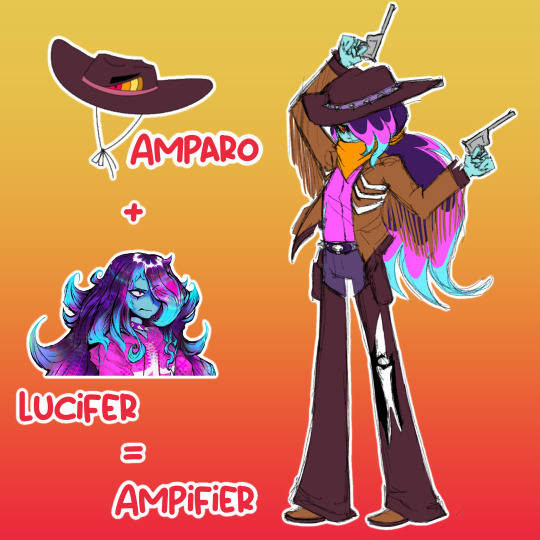
Me and @arcadekitten have Magician on the brain… She drew her character Olympia and Cassio fused, so I drew her other character Amparo fused with Lucifer! (They fused together to get their individual idiots back)
85 notes
·
View notes
Text
Ampify Studio the free desktop app - everything you need to make music in minutes!
Ampify Studio the free desktop app – everything you need to make music in minutes!
Ampify, born out of well-known electronic music brand Novation, and as part of the Focusrite Group, is on a mission to make music-making more accessible to the masses with Ampify Studio, the new music-making desktop app available for Windows and Mac. Simply download for free and start building arrangements in just a few clicks. Whether you’re at the beginning of your musical journey or taking…

View On WordPress
0 notes